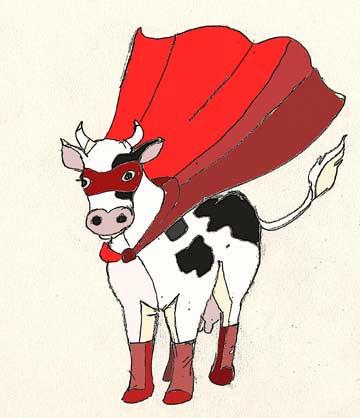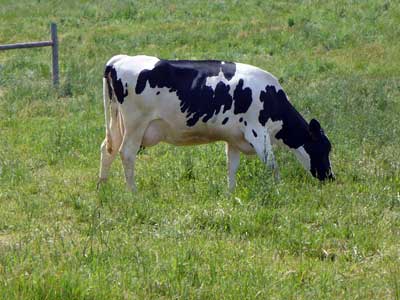Lactoferrin: Powerful Immune Booster
Lactoferrin (Lf) is a whey glycoprotein which assists the immune system. This little molecule is one of dairy's superheroes. It has antiviral, antimicrobial, anti-inflammatory and  anticancer properties (Rodrigues et al. 2009, Kanwar and Kanwar 2013, Guedes et al. 2018). Lactoferrin is produced by the body but research has shown that consuming dietary Lf has similar benefits (Tomita et al. 2009). Acid whey is a good dietary source of lactoferrin. It contains 1% Lf by dry weight.
anticancer properties (Rodrigues et al. 2009, Kanwar and Kanwar 2013, Guedes et al. 2018). Lactoferrin is produced by the body but research has shown that consuming dietary Lf has similar benefits (Tomita et al. 2009). Acid whey is a good dietary source of lactoferrin. It contains 1% Lf by dry weight.
Why Does the Body Need Lactoferrin?
Lactoferrin is found naturally in human tears, nasal secretions, saliva, bronchial mucus, gastrointestinal juices, vaginal mucus, and semen. These areas are exposed to dangerous invading microbes every day (Yates et al. 2006). Lactoferrin works to protect all of these areas from harmful microbes, funguses and other disease causing pathogens. Lactoferrin has several modes of action, including binding iron to prevent bacteria from replication. Many pathogen causing bacteria need iron to survive (Bullen et al. 2005).
In addition, stomach pepsin digests lactoferrin releasing lactoferricin, a powerful antibiotic that neutralizes bacteria, fungus, viruses and parasites (Vogel 2012). Lactoferricin promotes a healthy digestive tract by protecting beneficial intestinal microflora (Sherman 2013).
How Lactoferrin Boosts the Immune System
Very simple explanation:
Lactoferrin helps to regulate the immune system. When harmful bacteria or viruses invade the body, Lf slows their growth, prevents them from reproducing or kills them outright. While putting invading microbes in a headlock, Lf recruits other immune cells to help out in the rumble. Once the viruses and microbes are crying for mercy, Lf slows down the immune response to prevent 'civilian' casualties. Uncontrolled immune responses can cause cellular damage or allergenic attacks so it is important to keep control of the situation.
Need more reason to like Lf on Face Book? When it is not kicking microbe butt, Lf is helping to prevent cancer.
More scientific summary:
Instead of blindly responding to potential threats, Lf modulates the immune system (Tomita et al. 2009, Legrand 2012). This means that Lf up-regulates or down-regulates immune responses. By reacting this way, Lf can help formulate a custom immune response to any threat. Lactoferrin also may help prevent or calm down allergic reactions.
Lactoferrin has an important role in modulating the immune response to threats.
1) First, Lf stops and/or slows microbe (bacteria, viruses and others) replication and growth (Rodrigues et al. 2009, Legrand 2012):
Lactoferrin snatches up and binds iron needed by bacteria, parasites and yeast cells. Lack of iron inhibits microbes' growth and reproduction. Lactoferrin disrupts microbe membranes. This kills or cripples the microbes. Lactoferrin prevents microbes from binding to host cells and/or disrupts microbe/membrane binding. Lactoferrin disrupts cell-viral interactions. This prevents viruses from attaching to cells and slows viral replication.
2) Second, Lf recruits more immune system fighters (Rodrigues et al. 2009, Legrand 2012):
Lactoferrin activates innate immune cells such as neutrophils and macrophages. This is like giving the order to arm and aim an extremely powerful microbe blaster at microbes. Lactoferrin attract immune cells to itself in order to obtain help in destroying pathogenic microbes. Lactoferrin activates T-cell response.
3) Third, once the immune system has gotten the infection under control, Lf acts quickly to down-regulate the immune response and reduce inflammation (Tomita et al. 2009). You don’t want your body to be on heightened alert all the time. Chronic inflammation has been linked to metabolic disorders such as high blood pressure, high blood lipid concentrations, diabetes and gaining weight around the middle (very few people seem to desire this with the possible exception of sumo wrestlers). In addition, an uncontrolled immune response can cause cellular and tissue damage.
One way Lf downsizes immune response is by binding endotoxin or lipopolysaccharides (LPS), pro-inflammatory molecules that attract immune cells (Vogel 2012). By binding LPS, Lf prevents them from attracting more immune cells. This down-regulates immune system activities and reduces inflammation. Some components of LF also neutralize LPS.
Lactoferrin Fights Inflammation
Lf is anti-inflammatory (Legrand 2012). Over all body inflammation, or ‘metaflammation’ is believed to be responsible for metabolic disorders such as diabetes, high blood pressure, abnormal blood lipids and obesity. 
Picture: A Holstein dairy cow eats a high antioxidant 'green' lunch.
Lactoferrin inhibits production of the pro-inflammatory cytokines, TNF-α, IL-β and IL-6, in mononuclear cells.
Lactoferrin encourages production of the anti-inflammation cytokines, IL-4, IL-10 and IL-11. Lactoferrin decreases recruitment of immune cells in inflammation sites. This helps prevent over reaction of the immune system (Yamauchi et al. 2006). Lactoferrin may also reduce inflammation caused by allergies or autoimmune disorders.
Some forms of Lf destabilize the pro-inflammatory cytokines, tryptase, chymase and cathepsin G, that are released by mast cells. This helps slow down the cytokine storm of inflammatory chemicals which can cause a full blown allergic reaction.
Lactoferrin's iron binding abilities help protect the body from reactive oxygen species (ROS). It binds free iron even at low pH levels, preventing the formation of hydroxyl radicals which damage lipids and fats in the body. Damaged lipids can cause inflammation.
Lactoferrin Helps Prevent Cancer
Lactoferrin inhibits cancers (Parodi 2007, Rodrigues et al. 2009, Tsuda et al. 2010, Pepe et al. 2013, Guedes et al. 2018). Research shows that consuming lactoferrin inhibits cancer carcinogenesis, proliferation and metastasis (Tsuda et al. 2010). A component of Lf, LfcinB, is able to specifically target cancer cells without harming healthy cells. Cancer cells have a highly negative membrane charge which attracts Lf, while healthy normal cells have a neutral charge (Burdick et al. 1997). Lactoferrin is attracted to the cancer cells, attaches to them and triggers a process that kills the cancer cell. Guedes et al. (2018) found that Lf kills highly metastatic cancer cell lines by inhibiting cell proliferation, inducing apoptosis, causing intracellular acidification, and inhibiting lysosomal acidification. Lf does not have this effect in non-cancerous or healthy cell lines.
Lactoferrin triggers cancers cells to commit suicide; this process is called apoptosis. Lactoferrin inhibits the formation of blood vessels in tumors. Formation of blood vessels is called angiogenesis and is needed for cancer growth. Tumors need a steady supply of blood to deliver nutrients to their inner cells. They must stimulate blood vessels to grow. Without a blood supply tumors remain small and relatively harmless. Lactoferrin modulates carcinogen metabolizing enzymes. Lactoferrin inhibits lysosomal acidification in cancer cells. Lyosomes produce cathepsins, a family of proteases (enzymes that break amino acid bonds to break down proteins). Cathepsins are altered in cancer cells in a way that may help cancers invade other cells, become more mobile and encourage angiogenesis (Fehrenbacher and Jäättelä 2005). Changing the pH of the lyosome can make cathepsins inactive and stop cancers from spreading.
In a meta-analysis of 600 women, lactoferrin effectively treated iron deficiency anemia in pregnant women without the gastrointestinal side effects of high dose iron supplements (Hashim et al. 2017). Lactoferrin was recommended as a safe effective treatment of iron deficiency anemia in pregnant women.
Other interesting facts: The component of dairy lactoferrin responsible for its ability to blast micro-organisms and fight tumors is bovine lactoferrin fragment (LfcinB) (Pepe et al. 2013). This smaller chunk of Lf is unable to bind iron so it compensates by turning on the microbe and tumor killing power.
Lf may help fight fat by inhibiting adipogenesis and promoting lipolysis in white fat cells (Ikoma-Seki et al. 2015) while encouraging brown fat cells to increase energy expenditure through UCP1 (Nakamura et al. 2018).
References:
Bullen JJ, Rogers HJ, Spalding PB, Ward CG. Iron and infection: the heart of the matter. FEMS Immunol Med Microbiol. 2005;43:325-30. Pubmed. Burdick MD, Harris A, Reid CJ, Iwamura T, Hollingsworth MA. Oligosaccharides expressed on MUC1 by pancreatic and colon tumor cell lines. Journal of Biological Chemistry. 1997;272:20202–24198. Pubmed. Full text. Fehrenbacher N, Jäättelä M. Lysosomes as Targets for Cancer Therapy. Cancer Res. 2005;65:2993-2995. doi: 10.1158/0008-5472.CAN-05-0476 Guedes JP, Pereira CS, Rodrigues LR, Côrte-Real M. Bovine Milk Lactoferrin Selectively Kills Highly Metastatic Prostate Cancer PC-3 and Osteosarcoma MG-63 Cells In Vitro. Front. Oncol. 2018;8:200. doi: 10.3389/fonc.2018.00200 Abu Hashim H, Foda O, Ghayaty E. Lactoferrin or ferrous salts for iron deficiency anemia in pregnancy: A meta-analysis of randomized trials. Eur J Obstet Gynecol Reprod Biol. 2017;219:45-52. doi: 10.1016/j.ejogrb.2017.10.003 Legrand D. Lactoferrin, a key molecule in immune and inflammatory processes. Biochem Cell Biol. 2012;90:252-68. Pubmed. doi: 10.1139/o11-056 Ikoma-Seki K, Nakamura K, Morishita S, Ono T, Sugiyama K, Nishino H, et al. Role of LRP1 and ERK and cAMP Signaling Pathways in Lactoferrin-Induced Lipolysis in Mature Rat Adipocytes. PLoS ONE 2015;10(10): e0141378. Full text. Kanwar RK, Kanwar JR. Immunomodulatory lactoferrin in the regulation of apoptosis modulatory proteins in cancer. Protein Pept Lett. 2013;20:450-8. Pubmed. Nakamura K, Kishida T, Ejima A, Tateyama R, Morishita S, Ono T, Murakoshi M, Sugiyama K, Nishino H, Mazda O. Bovine lactoferrin promotes energy expenditure via the cAMP-PKA signaling pathway in human reprogrammed brown adipocytes. BioMetals. 2018;31:415. Pubmed. Paesano R, Pietropaoli M, Gessani S, Valenti P. The influence of lactoferrin, orally administered, on systemic iron homeostasis in pregnant women suffering of iron deficiency and iron deficiency anaemia. Biochimie 91. 2009;91:44-51. Pubmed. Parodi PW. A role for milk proteins and their peptides in cancer prevention. Current Pharmaceutical Design. 2007;13:813–828. Pubmed. Pepe G, Tenore GC, Mastrocinque R, Stusio P, Campiglia P. Potential Anticarcinogenic Peptides from Bovine Milk. J of Amino Acids. 2013, Article ID 939804, 7 pages. Pubmed. doi: 10.1155/2013/939804 (full text) Rodrigues L, Teixeira J, Schmitt F, Paulsson M, Månsson HL. Lactoferrin and cancer disease prevention. Crit Rev Food Sci Nutr. 2009;49:203-17. Pubmed. doi: 10.1080/10408390701856157 Sherman MP. Lactoferrin and necrotizing enterocolitis. Clin Perinatol. 2013;40:79-91. Pubmed. doi: 10.1016/j.clp.2012.12.006. Tomita M, Wakabayashi H, Shin K, Yamauchi K, Yaeshima T, Iwatsuki K. Twenty-five years of research on bovine lactoferrin applications. Biochimie. 2009;91:52-7. Pubmed. doi: 10.1016/j.biochi.2008.05.021 Tsuda H, Kozu T, Iinuma G, Ohashi Y, Saito Y, Saito D, Akasu T, Alexander DB,
Futakuchi M, Fukamachi K, Xu J, Kakizoe T, Iigo M. Cancer prevention by bovine lactoferrin: from animal studies to human trial. Biometals. 2010;23:399–409. Pubmed. doi: 10.1007/s10534-010-9331-3Yamauchi, K., Wakabayashi, H., Shin, K., and Takase, M. Bovine lactoferrin: benefits and mechanism of action against infections. Biochem. Cell Biol. 2006;84:291–296. doi:10.1139/o06-054. Pubmed. Yates A, Antia R, Regoes RR. How do pathogen evolution and host heterogeneity interact in disease emergence? Proc Biol Sci. 2006;273:3075-83. Pubmed. Full text. Vogel HJ. Lactoferrin, a bird's eye view. Biochem Cell Biol. 2012;90:233-44. Pubmed. doi: 10.1139/o2012-016.
